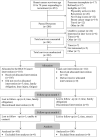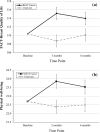Effects of the BEAT Cancer physical activity behavior change intervention on physical activity, aerobic fitness, and quality of life in breast cancer survivors: a multicenter randomized controlled trial
- PMID: 25417174
- PMCID: PMC4435784
- DOI: 10.1007/s10549-014-3216-z
Effects of the BEAT Cancer physical activity behavior change intervention on physical activity, aerobic fitness, and quality of life in breast cancer survivors: a multicenter randomized controlled trial
Abstract
Most breast cancer survivors (BCS) are not meeting recommended physical activity guidelines. Here, we report the effects of the Better Exercise Adherence after Treatment for Cancer (BEAT Cancer) behavior change intervention on physical activity, aerobic fitness, and quality of life (QoL). We randomized 222 post-primary treatment BCS to the 3-month intervention (BEAT Cancer) or usual care (UC). BEAT Cancer combined supervised exercise, face-to-face counseling, and group discussions with tapering to home-based exercise. Assessments at baseline, immediately post-intervention (month 3; M3), and 3 months post-intervention (month 6; M6) included accelerometer and self-reported physical activity, submaximal treadmill test, and QoL [Functional Assessment of Cancer Therapy (FACT)-Breast scale]. Adjusted linear mixed-model analyses demonstrated significant effects of BEAT Cancer compared to UC on weekly minutes of ≥ moderate intensity physical activity at M3 by accelerometer [mean between group difference (M) = +41; 95 % confidence interval (CI) = 10-73; p = 0.010] and self-report (M = +93; CI = 62-123; p < 0.001). Statistical significance remained at M6 for self-reported physical activity (M = +74; CI = 43-105; p < 0.001). BEAT Cancer participants were significantly more likely to meet physical activity recommendations at both time points [accelerometer M3 adjusted odds ratio (OR) = 2.2; CI = 1.0-4.8 and M6 adjusted OR = 2.4; CI = 1.1-5.3; self-report M3 adjusted OR = 5.2; CI = 2.6-10.4 and M6 adjusted OR = 4.8; CI = 2.3-10.0]. BEAT Cancer significantly improved fitness at M6 (M = +1.8 ml/kg/min; CI = 0.8-2.8; p = 0.001) and QoL at M3 and M6 (M = +6.4; CI = 3.1-9.7; p < 0.001 and M = +3.8; CI = 0.5-7.2; p = 0.025, respectively). The BEAT Cancer intervention significantly improved physical activity, fitness, and QoL with benefits continuing 3 months post-intervention.
Figures




References
-
- Speck RM, Courneya KS, Masse LC, Duval S, Schmitz KH. An update of controlled physical activity trials in cancer survivors: a systematic review and meta-analysis. J Cancer Surviv: Res Pract. 2010;4(2):87–100. - PubMed
-
- Ibrahim EM, Al-Homaidh A. Physical activity and survival after breast cancer diagnosis: meta-analysis of published studies. Med Oncol. 2011;28(3):753–765. - PubMed
-
- Rock CL, Doyle C, Demark-Wahnefried W, Meyerhardt J, Courneya KS, Schwartz AL, Bandera EV, Hamilton KK, Grant B, McCullough M, et al. Nutrition and physical activity guidelines for cancer survivors. CA Cancer J Clin. 2012;62(4):243–274. - PubMed
-
- National Comprehensive Cancer Network Survivorship version 1.2013. NCCN Clinical Practice Guidelines in Oncology (NCCN Guidelines) 2103
Publication types
MeSH terms
Grants and funding
LinkOut - more resources
Full Text Sources
Other Literature Sources
Medical

